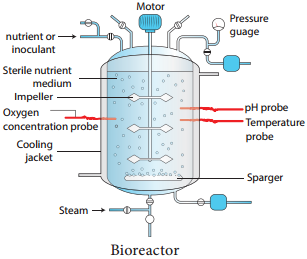Learninsta presents the core concepts of Biology with high-quality research papers and topical review articles.
Methods Of Biotechnology
Fermentation
The word fermentation is derived from the Latin verb ‘fervere’ which means ‘to boil’. Fermentation refers to the metabolic process in which organic molecules (normally glucose) are converted into acids, gases, or alcohol in the absence of oxygen or any electron transport chain.
The study of fermentation, its practical uses is called zymology and originated in 1856, when French chemist Louis Pasteur demonstrated that fermentation was caused by yeast.
Fermentation occurs in certain types of bacteria and fungi that require an oxygenfree environment to live. The processes of fermentation are valuable to the food and beverage industries, with the conversion of sugar into ethanol to produce alcoholic beverages, the release of CO2 by yeast used in the leavening of bread, and with the production of organic acids to preserve and flavour vegetables and dairy products.
Bioreactor (Fermentor)
Bioreactor (Fermentor) is a vessel or a container that is designed in such a way that it can provide an optimum environment in which microorganisms or their enzymes interact with a substrate to produce the required product. In the bioreactor aeration, agitation, temperature and pH are controlled. Fermentation involves two process namely upstream and downstream process.
(i) Upstream process
All the process before starting of the fermenter such as sterilization of the fermenter, preparation and sterilization of culture medium and growth of the suitable inoculum are called upstream process.
(ii) Downstream process
All the process after the fermentation process is known as the downstream process. This process includes distillation, centrifuging filtration and solvent extraction. Mostly this process involves the purification of the desired product.

Procedure of Fermentation
- Depending upon the type of product, bioreactor is selected.
- A suitable substrate in liquid medicine is added at a specific temperature, pH and then diluted.
- The organism (microbe, animal/plant cell, sub-cellular organelle or enzyme) is added to it.
- Then it is incubated at a specific temperature for the specified time.
- The incubation may either be aerobic or anaerobic.
- Withdrawal of product using downstream processing methods.
Application of fermentation in industries
Fermentation has industrial application such as:
1. Microbial biomass production
Microbial cells (biomass) like algae, bacteria, yeast, fungi are grown, dried and used as source of a complete protein called ‘single cell protein (SCP)’ which serves as human food or animal feed.
2. Microbial metabolites
Microbes produce compounds that are very useful to man and animals. These compounds called metabolites, can be grouped into two categories:
a. Primary metabolites:
Metabolites produced for the maintenance of life process of microbes are known as primary metabolites Eg. Ethanol, citric, acid, lactic acid, acetic acid.
b. Secondary metabolites:
Secondary metabolites are those which are not required for the vital life process ofmicrobes, but have value added nature, this includes antibiotics e.g – Amphotericin – B (Streptomyces nodosus), Penicillin (Penicillium chryosogenum) Streptomycin (S. grises), Tetracycline (S. aureofacins), alkaloids, toxic pigments, vitamins etc.
3. Microbial enzymes
When microbes are cultured, they secrete some enzymes into the growth media. These enzymes are industrially used in detergents, food processing, brewing and pharmaceuticals. Eg. protease, amylase, isomerase, and lipase.
4. Bioconversion, biotransformation or modification of the substrate
The fermenting microbes have the capacity to produce valuable products, eg. conversion of ethanol to acetic acid (vinegar), isopropanol to acetone, sorbitol to sorbose (this is used in the manufacture of vitamin C), sterols to steroids.
Single Cell Protein (SCP)
Single cell proteins are dried cells of microorganism that are used as protein supplement in human foods or animal feeds. Single Cell Protein (SCP) offers an unconventional but plausible solution to protein deficiency faced by the entire humanity.
Although single cell protein has high nutritive value due to their higher protein, vitamin, essential amino acids and lipid content, there are doubts on whether it could replace conventional protein sources due to its high nucleic acid content and slower in digestibility. Microorganisms used for the production of Single Cell Protein are as follows:
- Bacteria – Methylophilus methylotrophus, Cellulomonas, Alcaligenes
- Fungi – Agaricus campestris, Saccharomyces cerevisiae (yeast), Candida utilis
- Algae – Spirulina, Chlorella, Chlamydomonas
The single cell protein forms an important source of food because of their protein content, carbohydrates, fats, vitamins and minerals. It is used by Astronauts and Antarctica expedition scientists.
Spirulina can be grown easily on materials like waste water from potato processing plants (containing starch), straw, molasses, animal manure and even sewage, to produce large quantities and can serve as food rich in protein, minerals, fats, carbohydrate and vitamins. Such utilization also reduces environmental pollution. 250 g of Methylophilus methylotrophus, with a high rate of biomass production and growth, can
be expected to produce 25 tonnes of protein.
Applications of Single-Cell Protein
- It is used as protein supplement
- It is used in cosmetics products for healthy hair and skin
- It is used as the excellent source of protein for feeding cattle, birds, fihes etc.
- It is used in food industry as aroma carriers, vitamin carrier, emulsifying agents to improve the nutritive value of baked products, in soups, in ready-to-serve-meals, in diet recipes.
- It is used in industries like paper processing, leather processing as foam stabilizers.